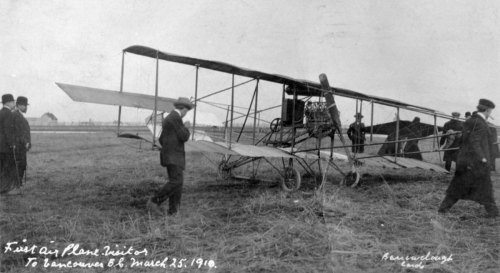Charles Hamilton
This Week in History: 1910: The crazy man of the air makes Vancouver's first flight
Charles K. Hamilton was a daredevil who crashed over 60 times in his short career
Author of the article: John Mackie. Vancouver Sun. Publishing date: Mar 19, 2021
On March 25, 1910, American Charles K. Hamilton made the first airplane flight in Vancouver in a Curtiss Reims Racer biplane.
“Man’s conquest of the air was pretty well demonstrated by Chas. K. Hamilton, the bird-man, out at Minoru racetrack yesterday,” the Vancouver World reported. “Over 3,000 twirled the turnstiles at $1 per twirl and another 2,000 whose only expense was car fare out to the race track to witness the first flights of a heavier-than-air machine in western Canada.”
Actually, the first airplane flight in the west was in Winnipeg in July, 1909. But hype was one of the hallmarks of early aviation, when daredevils risked life and limb most every time they climbed into the cockpit.
Hamilton knew this all too well — two weeks earlier he had crashed during an exhibition in Seattle. His tour-de-force was rising high in the sky, cutting his engine and “downward gliding” to earth before starting the engine again and setting the plane “gently as a bird” on the ground. His trick worked three times in Seattle, but when he tried it a fourth time a wing clipped a pond beside Meadows racetrack and “the monster spider collapsed and went down in the water, with Hamilton entangled.”

Charles K. Hamilton, “First Air Plane Visitor to Vancouver B.C.,” March 25, 1910. Postcard.
George Alfred Barrowclough/Vancouver Archives AM54-S4-: Air P43
George Alfred Barrowclough/Vancouver Archives AM54-S4-: Air P43
Early planes were fairly fragile — Hamilton’s “steering gear” broke while he was in mid-air during his first flight at Minoru, which was also a racetrack. He managed to land, but damaged his plane doing so, forcing him to cancel two of his four scheduled flights. But nobody seemed to be too upset, because he had wowed them with the two flights he made.
Hamilton cut a dashing figure, striding out to the plane, “nonchalantly smoking a cigarette.” After pulling his “motor cap down a little more firmly over his eyes,” he climbed into the cockpit and assistants turned over the “five foot propeller” to start the engine.
“Buzz, went the eight-cylinder exhaust, (and) the machine started along the smooth surface of the track, the speed increasing every foot, until by the time 50 yards had been traversed the aviator was going at the rate of 25 miles per hour,” said the World.
“Just near the judges stand and right under the eyes of the thousands in the grandstand, Hamilton shoved down the steering lever just a trifle. This tilted up the two smaller planes in the front of the machine, and like some huge bird, it left the earth and soared gracefully into the air.
“The crowd cheered heartily as Hamilton rose and then the spectators watched in silent awe, broken only by occasional admiring exclamations, as like a huge primrose eagle, the aeroplane darted off almost in a direct line with the Lions, as though it were some great bird seeking its aerie far up on the snow-capped peaks.”
Hamilton flew northwest, then turned back and flew towards Steveston. Turning east, he buzzed around 200 feet in the air before “swooping downward about 50 feet and swinging partly in over the grandstand.” Flying “directly over the heads of the crowd” led to a “tumult of cheering” from the spectators.
His second flight concluded with the “much-heralded Hamilton Glide.” He cut off his engine at 100 feet in the air, gliding downwards at a 35-degree angle. “Just when it looked like the big yellow-winged machine was going to take a plunge straight into the ground, the cool and clever aviator tilted the planes up in front a little, at the same time throwing himself back in his seat,” said the World.
“The wheels touched a little hummock but the touch was as light as feather, and the machine, with diminishing speed, flew along the ground” until it “was brought to a stop by its front wheel ploughing through the soft loam of a little knoll.”
Incredibly, Charles Keeney Hamilton had only learned to fly in 1909. He became internationally famous three months after his Richmond flight when he won a $10,000 prize in a contest sponsored by the New York Times to fly between New York and Philadelphia and back.
Hamilton was fearless, and is believed to have crashed over 60 times, breaking or fracturing many bones. (Some might have been when he flew in dirigibles, hot air balloons and kites before he became a pilot.) His derring-do led to the nickname “the crazy man of the air.”
He died on Jan. 22, 1914 at the age of 28. But he didn’t perish in a plane crash — he died from an “internal hemorrhage” after getting tuberculosis.
jmackie@postmedia.com